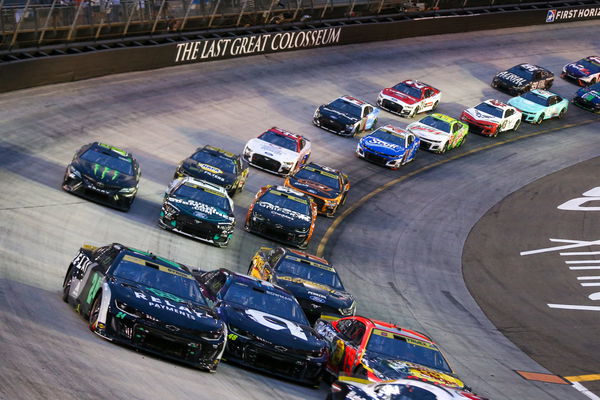
USA Today via Reuters
Sep 16, 2023; Bristol, Tennessee, USA; NASCAR Cup Series driver William Byron (24) and driver Martin Truex Jr. (19) and driver Alex Bowman (48) during the Bass Pro Shops Night Race at Bristol Motor Speedway. Mandatory Credit: Randy Sartin-USA TODAY Sports

USA Today via Reuters
Sep 16, 2023; Bristol, Tennessee, USA; NASCAR Cup Series driver William Byron (24) and driver Martin Truex Jr. (19) and driver Alex Bowman (48) during the Bass Pro Shops Night Race at Bristol Motor Speedway. Mandatory Credit: Randy Sartin-USA TODAY Sports
“It’s the same package. It’s the same tire combination…still a bit of an unknown.” These words came out of none other than Greg Stucker, Goodyear racing director, after the Spring Bristol race. That race was phenomenal due to a happy accident—the tire company used a compound from another race. Drivers were driven to the edge of their talents as they controlled the tire strategy. However, replicating that race was in vain—and it is still a bit of an unknown.
But is it though? NASCAR experts beg to disagree, as they narrow their lenses to NASCAR instead of Goodyear for this mishap. The recently unfolded playoff race at Bristol was a polar opposite of spring—and people believe the sport’s Next-Gen car is at fault.
ADVERTISEMENT
Article continues below this ad
NASCAR is not escaping the radar easily
Ever since the Next Gen car debuted in 2022, NASCAR has been riddled with complaints. Ranging from its initial high-risk injuries to a boring racing product, the racing community is frustrated. However, the faults of the Next Gen car are most prominent on short tracks. Lead changes are hugely lacking as drivers struggle to pass due to low horsepower and aerodynamic issues. That is what we witnessed at the Bass Pro Shops Night Race. Instead of following the spring race’s exceptional precedent, drivers and fans fell prey to a snoozer of a race.
NASCAR expert Eric Estepp said that expectations did not soar as high as in the spring. “No one expected the tires to blow in 40 laps. But we also didn’t expect them to last 140 laps.” And Estepp believes it is not entirely Goodyear’s fault that Kyle Larson ended up leading most of the race. “Goodyear does not deserve all of the blame for last night’s race – little tire wear, little passing, one driver dominating and leading over 460 laps. That is not Goodyear’s fault – NASCAR and their Next Gen car deserve much of the blame…the car has serious short-track design flaws.”

USA Today via Reuters
Sep 17, 2022; Bristol, Tennessee, USA; NASCAR Cup Series driver Christopher Bell (20) and driver Kyle Larson (5) and driver William Byron (24) and driver Brad Keselowski (6) during the Bass Pro Shops Night Race at Bristol Motor Speedway. Mandatory Credit: Randy Sartin-USA TODAY Sports
Estepp suggested that Goodyear’s frantic efforts to control its tire package were just a rescue attempt. “They have asked Goodyear to bail them out…and sometimes, they have. the Bristol spring race for example…introducing options tires at Richmond.” But slipping up at a crucial time as the playoffs hurts the sport’s image, especially when fans are doling out hefty dollars to watch. “We’re in the playoffs, there should be some amount of predictability. When you expect fans to travel long distances and spend lots of money on tickets – they should have a decent idea of what the product in front of them is going to look like.”
ADVERTISEMENT
Article continues below this ad
As it turns out, this is not the first time that Goodyear has scratched its head about its tire product. And it may be time for the company to buckle up.
Trending
What’s your perspective on:
How long can NASCAR rely on Goodyear before fans demand a change for better short-track performance?
Have an interesting take?
Another confusing scenario?
“But numerous races, Goodyear had not delivered what many of us were promised…I don’t think we can trust anything Goodyear says.” After supporting the tire brand against NASCAR, Estepp could not help but slip in a bad word as well. As we have witnessed, Goodyear has not been able to control its tire product—spring’s Bristol race baffled both the brand and NASCAR. Their replication attempts were largely unsuccessful—the All-Star Race and now the Bristol playoff race. But as it turns out, this head-scratching tendency dates back over 15 years, when Goodyear was just as clueless.
ADVERTISEMENT
Article continues below this ad
In an Indianapolis Cup race in 2008, right-side tires wore out so fast that NASCAR had to wave caution flags every 10 or 12 laps. Called the ‘Tiresome 400’, this race witnessed tires giving off a fine black powder instead of rubbering the track. And just like 2024, Goodyear was baffled even then. Then-General Manager Stu Grant said: “The results that we saw on Sunday were certainly unexpected. We went in there with a proven tire, a known quantity. We didn’t see anything different in our test data from April to indicate a problem.” He added, “The whole combination of that tire, the Car of Tomorrow on that racetrack caused that right rear tire to wear like we had never seen before.”
Evidently, 2024 is not the first time Goodyear has accidentally introduced an unexpected product. Let us see if NASCAR and the tire brand succeed in controlling the package in the future.
ADVERTISEMENT
ADVERTISEMENT
ADVERTISEMENT
ADVERTISEMENT







How long can NASCAR rely on Goodyear before fans demand a change for better short-track performance?